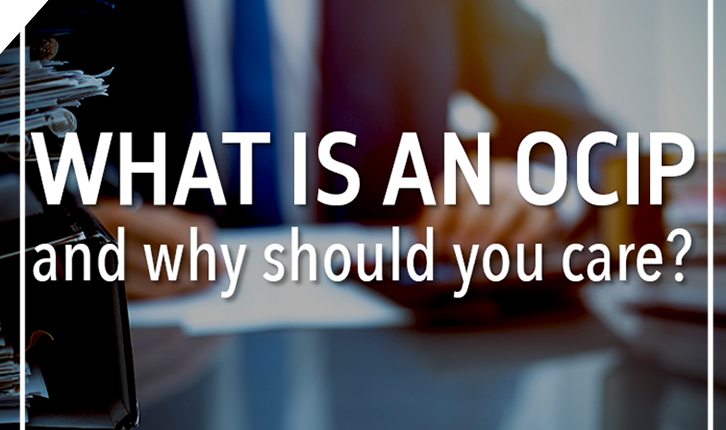
What is an OCIP, and Why Should You Care?
An OCIP, or Owner Controlled Insurance Program, is commonly found in place on large construction projects, especially residential developments. These are insurance programs set up by the project owner/developer and are designed to cover all contractors working on the project, from the Architects and Engineers, to the structural framing and cement contractors, to the cabinet installers and low voltage electricians putting in the final pieces. OCIPs are designed to provide more control and security to the project owner, as they ensure proper insurance is in place for all participating contractors. OCIPs are often a more convenient solution for larger developments, because such large projects often are difficult for individual contractors to get insurance on, given the limitations found more frequently on their smaller policies.
OCIPs can be set up to provide a variety of different insurance coverages, the most common being Commercial General Liability (CGL).
Q: How are OCIPs paid for, and how does this affect you as a contractor on the project?
OCIPs are often paid for by the Developer and/or Prime General Contractor, with applicable premiums charged back to participating subcontractors via deductions from payments for their work invoices as submitted. For example, a contractor should receive an OCIP information packet during the bidding process, describing the coverage provided and how to enroll. During the enrollment process, there is normally a process to ascertain what the premium rates charged will be for various trades. Sometimes this is shown on a rate sheet. Other times this is established by the OCIP administrator requesting a copy of the participating contractor’s insurance policy to identify their existing rates so that the OCIP can charge the same rates, keeping the participating contractor’s insurance cost stable.
NOTE: Most standard contractor’s CGL policies contain an exclusion for work covered under “other insurance”, such as an OCIP, which keeps the contractor from paying twice for liability coverage on a given project.
Q: Is enrollment in an OCIP mandatory?
It depends on the project. Some projects make OCIP enrollment mandatory, where you can only work on the project if you accept its OCIP coverage; others make enrollment optional. It varies from project to project, and developer to developer.
Q: I enrolled in an OCIP project, why do I still need to provide proof of my own insurance?
OCIP coverage is limited to just the scope of the project described. However, the project owner/developer will want to make sure it is still shielded from litigation arising from “off-site operations” that one of its enrolled contractors may be involved in, whether related to the project or not. Verifying that enrolled contractors have their own insurance for their other operations is how this is accomplished.
Q: Ok, I’ve enrolled in a project’s OCIP program, does that mean I’m set and no longer have any paperwork responsibilities towards it?
Not quite, for at least 3 reasons:
- You’ll want to make sure you receive an insurance certificate from the OCIP showing its coverages and confirming that you’re enrolled in it. Save this for your own insurance policy’s year-end premium audit so you have proof that your work on that project was covered via the OCIP so you don’t have to pay premiums on it a second time under your own policy.
- Organize your accounting records so revenues from OCIP projects are clearly identified as separate from revenues you make from traditional non-OCIP projects. A simple way to do this is to create a sub-category in your accounting software for revenues received under an OCIP project. This way, if asked you can create a Profit & Loss report for your insurance audit that clearly shows which revenues should not be charged for by your policy.
- Keep your OCIP enrollment documents & files for the long term. Many OCIP policies have a range of applicable deductibles, depending on what trade or “level” a contractor was enrolled under. High end of deductibles range from $25k-$100k for structural contractors, and the low end being $1,000-$10k for some non-structural trades, such as cabinetry or low-voltage wiring. Deductible level assignment is often confirmed during the enrollment process, and sometimes can be negotiated by the enrolling contractor. Documentation supporting the deductible amount you arrive at should be retained indefinitely, as this can safeguard an enrolled contractor from being billed for a higher deductible years later, when defect litigation often manifests, and the OCIP then presents you with a demand for deductible payment.
OCIPs are an involved and complicated subject, and the questions above represent the most common ones on the topic we answer for our clients. Do you have questions about an OCIP? Call our office for expert advice, we’re here to help!

About the Author
Larry St. John is a 20+ year veteran of insurance and risk management for the construction and electronic security industries.
He can be reached at LStJohn@eclipseinsurance.com




